Introduction :
- Sexual reproduction is the process by which new organisms are formed from the fusion of male and female gametes from two parents.
- The flower is the primary reproductive structure. Within the flowers, the reproductive organs, or sporophylls, are produced.
- Sporophylls are classified into two types: microsporophylls (stamen) and megasporophylls (carpel).
- A carpel is an ovary that contains an ovule, a style, and a stigma.
- There are three types of stamen: filament, anther, and connective.
- Stamen is distinguished as filament, anther and connective.
Parts of a flower :
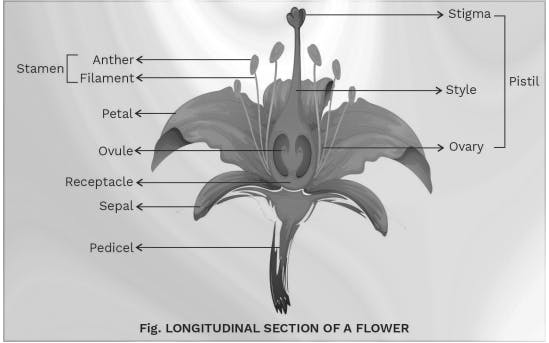
A flower comprises the following parts-
Calyx: It is the outermost whorl of a flower. It comprises units called sepals. In the bud stage, calyx encloses the rest of the flower. They usually exhibit green colouration, at some other instances, they may be a colour like petals. This state of Calyx is termed as petaloid. Calyx can either be prominent or absent.
Corolla: It consists of many numbers of petals and it is the second whorl of the flower. These petals are sometimes fragrant. They are coloured, thin and soft that would help in the process of pollination as they would attract animals and insects.
Reproductive Structure of a Flower
Androecium
It is the male reproductive part of a flower, comprising stamens and it is the third whorl. Each stamen comprises two parts, namely, anther and filament. The tip of the anther is supported by the filament. Here pollens are produced by meiosis and disappear eventually.
- Anther: This is a four-lobed sac-like structure responsible for pollen formation.
- Filaments: These thread-like structures are attached to the anther, and they keep the anther in place.
The transverse section of an anther is microsporangia that further forms a pollen sac. The pollen sac contains pollen grains.
Microsporangia and Microsporogenesis
Microsporogenesis involves the formation of microspores from microspore mother cells by meiotic division.
The structure of anther: The anther is the breeding part of stamens. Each anther is connected by two lobes. Each anther lobe comprises two pollen chambers located longitudinally. The microsporangium is sufficiently supplied with a number of pollen microspores.
Structure of Microsporangia
Microsporangia consist of:
1. Tapetum: The cells are multinucleate and this layer is one of the innermost layers of the wall.
2. Middle layer: It is composed of three to four layers of thin-walled cells. They are located just beneath the endothelium.
3. Endothecium: This layer is inner to the epidermis. Some cell develops cells of the endothelium.
4. Epidermis: It is a protective outermost single-layer. Cells of the epidermis in Arceuthobium develop a fibrous thickening and the epidermis is designated as exothecium.
- Formation of Pollen grains: The young anther soon becomes four-lobed as it comprises a homogenous mass of parenchymatous cells engirdled by the epidermis. Each archesporial initially present in hypodermal cells divides into the inner primary sporogenous cell and outer primary parietal cell. Each primary sporogenous cell splits to produce microsporocytes. Each microspore mother cell meiotically divides to form pollen grains.
- Microgametogenesis (Development of Male Gametophyte): Microspore is partially developed at this stage and it is the first cell of the male gametophyte. The wall of the pollen grain comprises exine (outer layer) and inline (inner layer). The outer layer comprises sporopollenin and the inner layer is made up of pectose and cellulose.
- Pre-pollination development: The microspores begin to germinate in situ. A smaller generative cell lies next to the spore wall. A callose layer is placed around the generative cell. Then, the callose layer dissolves. The anther then sheds the pollen grains. The released pollen grains are passed to the stigma through pollination. The pollen grain present on the stigma absorbs water and within some minutes, swells up. The wall of pollen tube secretes hydrolytic enzymes and exogenous pectinases creating a passage to enter. The generative and vegetative cells are supplied by the pollen tube. The generative cell splits forming two non-motile male gametes. Tube nucleus may disintegrate as there is no important function.
Gynoecium
It is the female reproductive organ and the last whorl of the flower. It is composed of pistil and occupies the central position of the thalamus. The stigma, style, and ovary are the components of the pistil. The ovary produces ovules internally. Through meiosis, ovules produce megaspores which in turn develops into female gametophytes. As a result, egg cells are produced.
Gynoecium can be:
Monocarpellary: The gynoecium consists of a single pistil. For eg., peas and beans.
Multicarpellary: Here, gynoecium comprises more than one pistil.
Syncarpous: It is the gynoecium with combined pistil. For eg., Tomato, cucumber.
Apocarpous: It is the gynoecium with free pistil. For eg., Lotus Vinca.
Pistil- Each pistil has three parts:
- Ovary: The ovary is a chamber where ovules (eggs) are stored, waiting for fertilization.
- Stigma: It is attached to the top of the carpel, where the pollen from other flowers lands.
- Style: It is a tubular structure that connects the ovary and the stigma. It is responsible for the transportation of pollen from the stigma to the ovary and holding the stigma in place.
Sexual reproduction in flowering plants can be broken down into three steps:
(i) Pre-fertilization
(ii) Double fertilization
(iii) Post-fertilization
Pre-Fertilization: Structure and Events
The following pre-fertilization events can be studied:
(i) Pollen grain formation
(ii) Embryo sac formation
(iii) Pollination
(iv) Pollen pistil interaction
POLLEN GRAIN FORMATION :
Male reproductive unit (Stamen)
- A stamen is an angiosperm's male reproductive unit. It is composed of an anther and a filament. The anther is bilobed, with each lobe containing four pollen sacs or microsporangia.
- A number of pollen grains are contained in each pollen sac. A dithecous anther's four pollen sacs are located in the four corners.
- Dithecous anther: An anther with two lobes connected by a non-sporangious tissue called the connective.
- The anther wall is composed of four layers of cells.
- To release pollen grains, anther dehiscence through slits.
Anther Development
- The development of an anther begins with a mass of homogeneous meristematic cells surrounded by an epidermis.
- Four lobes are formed, as are four layers of archesporial cells.
- Archesporial cells: A primitive cell or group of primitive cells that divide to form two types of cells: a primary parietal cell and a primary sporogenous cell.
- The parietal cell divides several times to form the anther wall, whereas the sporogenous cell divides less frequently to form microspores or the pollen mother cells (PMC).
- The tapetum is the innermost layer of the cell wall that comes into contact with the PMCs. In pollen formation, the tapetum plays a crucial role.
- Tapetum: This is a tissue found within the anther that feeds the growing spores.
- The endothecium is the layer beneath the epidermis.

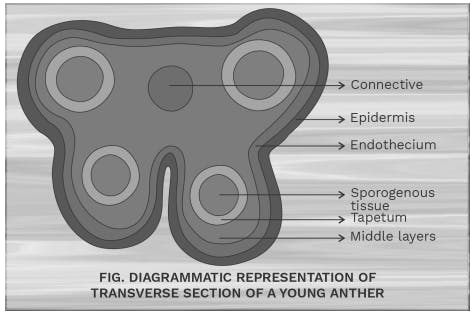
Wall Layers of Anther
- The epidermis is a single layer of cells that serves as a protective layer.
- Endothecium is a single-layered second wall. Cells are thickened with cellulose and a trace of pectin and lignin. It aids in the dehiscence of anthers.
- Middle layers – Ranges from 1-6. When the anther matures, the middle layer degenerates.
- Tapetum –
(a) The anther wall's innermost layer surrounding the sporogenous tissue.
(b) Tapetal cells contain nutrients.
(c) They have multiple nuclei and are polyploid.
(d) The ubisch bodies settle in the exine of the microspore wall.
(e) There are two kinds of tapetum:
(i) Secretary / glandular – The tapetal cells remain in place throughout the development of the microspore, eventually degenerating.
(ii) Amoeboid / periplasmodial – The tapetal cells rupture the radial wall, allowing the protoplast to enter the pollen chamber. These protoplasts are now joining together to form the periplasmodium.
Microsporogenesis
- Microsporogenesis is the formation and differentiation of microspores.
- PMCs go through meiosis. Tetrahedral tetrads are formed by each.
- Cytokinesis can be either sequential or simultaneous.
- Tetrads are classified into five types: tetrahedral, isobilateral, decussate, T-shaped, and linear. The most common shape is tetrahedral.
- The cell wall is formed after meiosis –I and meiosis –II in successive types, resulting in an isobilateral pollen tetrad. Monocots have it as a distinctive trait.
- In the simultaneous type, each nuclear division in a microspore mother cell is followed by the formation of a cell wall.
- The tetrahedral arrangement is separated from the microspores. After that, they are surrounded by a two-layered wall. The outer wall is known as the exine, and the inner wall is known as the intine.
- The pollen grains are the male gametophyte's first cells.
- The tapetum is depleted, and the anther becomes a dry structure. The pollen is liberated by the anther dehiscence.
- A tetrad's four nuclei remain functional to form four microspores.
- In some cases, all four pollen remain attached, forming compound pollen grains, as in Juncus jatropha.
- Microspores are present as pollinium in the Asclepiadaceae and Orchidaceae families.
- Pollinium: A mass of pollen grains found on each anther lobe. The entire mass of pollen grains is transferred as a unit when the pollinium is attached to pollinating agents such as insects.
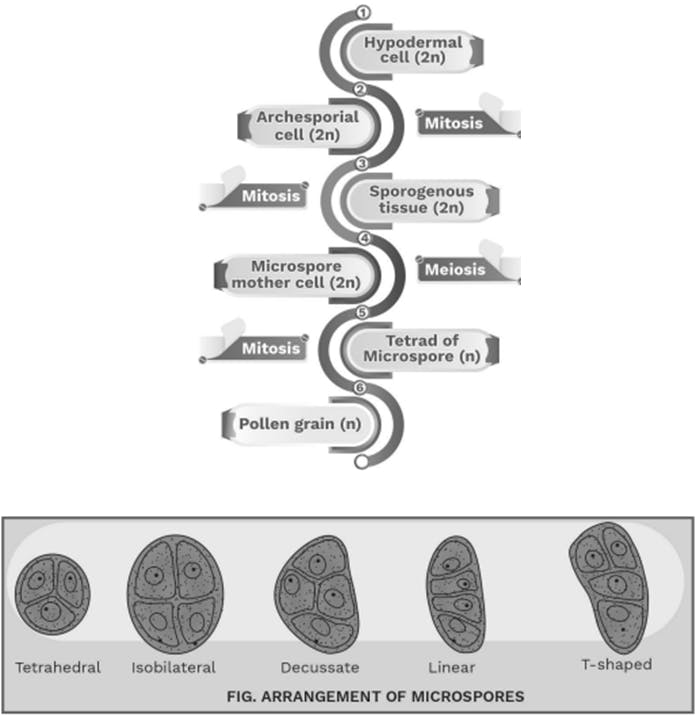
Development of the Microspore or Microsporogenesis
- After meiosis, four haploid microspores are produced which are enclosed by the callose wall.
- During the process of development, the enzyme Callase degrades the wall between the microspores and the microspores separate to form the pollen grains.
- The pollen grain further divides and forms two unequal cells.
- The larger cell is the vegetative cell that forms the pollen tube.
- The smaller cell forms the generative cell.
- The generative cell lies in the cytoplasm of the vegetative cell. The generative cell is elongated that helps it to move through the pollen tube.
- The vegetative cell has most of the cytoplasm and is needed to provide nutrition to the pollen grain.
- This pollen grain having the generative and vegetative cell is known as the two-celled stage. In some plants like the pollen grain is shed at two-celled stage.
- In other plant species like the generative cell divides by mitosis to form two male gametes or sperms.
- When the pollen grain has the vegetative cell and the two sperm cells, then, it is known as three-celled stage.

Pollen Grain
- Pollen grains come in all forms and sizes.
- It is generally round and has a diameter of 25 – 30m.
- The pollen grain has a haploid, unicellular body with a single nucleus. It has a two-layered exterior wall.
- The wall, or sporoderm, is made up of two layers.
- The outer layer is quite thick. It is known as the exine. It is composed of sporopollenin. • The inner wall is thin and is referred to as the intine. It is composed of pecto-cellulose.
- Exine can be thick and sculptured or smooth. It is cuticularised, and the cutin is sporopollenin, which is resistant to chemical and biological decomposition. This keeps the pollen wall intact for a long time. It also contains proteins that are involved in enzymatic and compatibility reactions.
- Exine is classified as inner endexine and outer ektexine. The ektexine is further subdivided into three layers: the inner continuous foot layer, the middle discontinuous baculate layer, and the outermost discontinuous tectum.
- Tectum aids in pollen grain identification and classification by family, genus, or species.
- Pollen grain has pores or furrows in it. The exine is not present in these areas. Germ pores are formed when the areas are circular. Germ furrows are formed when the areas are elongated.
- Intine is a thin and pliable material. It is composed of cellulose and pectin. The intine extends out to form the pollen tube during pollen germination.
- The pollen grains’ cytoplasm is high in starch and unsaturated oils. They begin to uninucleate and eventually become 2-3 celled.
- In Calotropis and orchids, the pollen of each anther lobe formed a characteristic mass known as pollinium.
- Pollen grains are classified as monoclopate (with one germ pore), biclopate (with two germ pores), or triclopate (with three germ pores).
- The study of pollen is termed palynology.
Development of Male Gametophyte
- Inside the pollen grain, the nucleus grows in size. It divides mitotically to give rise to two unequal daughter cells: a larger vegetative cell or tube cell and a smaller generative cell.
- Pollination can take place when the pollen grain is two-celled (tube + generative) or three celled (tube + two male gametes).
- In plants, however, such as cereals, male gametes form while the pollen is still within the anther. When pollen is shed at the two-celled stage, the generative cell divides after the pollen has landed on the stigma.
- The generative cell's cytoplasm contains little conserved food material, while the vegetative cell's cytoplasm includes fat, carbohydrate, and protein granules.
Pollen Products
1. Pollen supplements: Pollen grain is high in carbohydrates and unsaturated fat. They are taken in the form of tablets and syrups and are used to improve vital body functions. Pollen consumption boosts performance and is used by athletes as well as racehorses.
2. Pollen creams: Pollen grains provide UV protection. As a result, they are used in creams and emulsions to provide skin smoothness and protection.
Pollen Viability
- Pollen viability refers to the amount of time that pollen grains remain viable or functional.
- It is estimated by temperature and humidity.
- For 30 minutes, pollen grains are viable.
Pollen allergy
- Pollen grains cause severe allergies. It causes fever as well as common respiratory disorders such as asthma and bronchitis.
- Carrot grass (Parthenium hysterophorus) is a major allergen source. It also harms the internal organs of the body. It arrived in India alongside imported wheat.
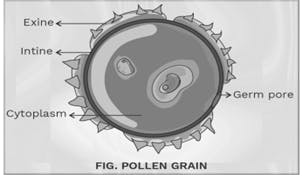
Female Reproductive Unit (Pistil)
- The female reproductive unit of a flower is the pistil or gynoecium.
- A carpel or pistil is made up of three parts: the stigma, the style, and the ovary.
- Stigma: The part of the body that receives pollen grains.
- The stalk that connects the stigma to the ovary is known as the style.
- Ovary: A swollen region at the base of the ovary. One to several ovules is found in the ovary.
- The ovule is a megasporangium surrounded by integuments. The ovule matures into a seed after fertilization. It is oval and whitish in colour.
- Funiculus: The stalk that joins the ovule and the placenta together.
- Hilum: The point at which the funicle attaches to the ovule.
- The fusion of the funiculus with the body of the ovule results in the formation of a raphe (ridge).
- The nucellus is a parenchymatous tissue that is equivalent to the megasporangium. The nucellus can be thin or thick.
- Chalaza refers to the origin of integuments.
- At the opposite end of the integuments from the chalazal end, there is a pore. Micropyle is the term for it.
- The developing embryo sac may be nourished by the inner region of the integument. It is known as endothelium.
- Cuticle covers the outer region of each integument and the nucellus.
- The integumentary cells of the castor bean (Ricinus) proliferate at the microplylar region. This results in a structure known as the caruncle. It serves two purposes.
i. It absorbs water and promotes seed germination. - ii. Because it is made of a sugary substance, ants disperse the seeds.

Megasporogenesis
- Megasporogenesis refers to the process of producing megaspores from megaspore mother cells.
- Ovules commonly form a single megaspore mother cell (MMC) in the nucellar micropylar region. It's a big cell with a lot of cytoplasms and a big nucleus.
- The MMC goes through meiosis to produce four megaspores.
- In most flowering plants, only one of the megaspores is active. The other three have devolved.
- Only the functional megaspore can mature into a female gametophyte.
- Monosporic development refers to the formation of an embryo sac from a single megaspore.
- Mitosis occurs in the nucleus of the functional megaspore, resulting in the formation of two nuclei. They shift to opposing poles. As a result, a two-nucleate embryo sac is formed.
- There are two more sequential mitotic nuclear divisions. This results in the formation of four nucleate and then eight nucleate embryo sac stages.
- Cell wall development does not occur immediately after nuclear division.
- Cell walls are formed after the eighth nucleate stage. This results in the formation of a typical female gametophyte or embryo sac. Six of the eight nuclei are encased in cell walls and organized into cells. The remaining two nuclei are known as polar nuclei.
- They are found in the large central cell, just beneath the egg apparatus. • Three cells are found together at the micropylar end. They make up the egg apparatus.
- The egg apparatus comprises two synergids and one egg cell. Filiform apparatus are special cellular thickenings at the micropylar tip found in synergids. They are crucial in directing pollen tubes into the synergid. Three cells are placed at the chalazal end. They are known as antipodals. At maturity, a typical angiosperm embryo sac has seven cells and eight nuclei.
Pollination
- Pollination is the transfer of pollen grains from the anther to the flower's stigma.
- Pollination can be categorised into two different types, namely: self-pollination and cross-pollination.
- Self-pollination refers to the transfer of pollen grains from anthers to stigmas of the same or different flowers on the same plant. Flowers in self-pollination are genetically similar.
Self-pollination is of two kinds- autogamy and geitonogamy.
1. Autogamy: The movement of pollen grains from the anther to the stigma of the same flower. It is preferred because of the following adaptations:
(a) Chasmogamous apparatuses
- When the mature anther and stigma of the flower are exposed to pollinating agents. The stigma in Lilac is directly beneath the anthers.
(b) Cleistogamy
- Because the flowers remain closed, self-pollination is the only option. Pisum, Lathyrus, and Commelina benghalensis are a few examples.
- Bisexual flowers mature their anthers and stigma well before the bud opens. Thus, self-pollination occurs during the bud stage of plants such as peas and wheat.
2. Geitonogamy is the transfer of pollen grain from one flower's anther to the stigma of another flower of the same or genetically similar plant.
The benefits of self Pollination are shown below.
- It preserves the race's purity.
- There is no need for the plant to produce a large number of pollen grains.
- It ensures seed production.
- Self-pollination eliminates undesirable recessive traits.
- Self-pollinated plants have a number of disadvantages as shown below.
- Variable, which reduces adaptability to changing environments.
- Vitality declines, eventually leading to degeneration.
Cross-Pollination
- It is defined as the transfer of pollen grains from an anther of one plant to the stigma of another plant of the same or different species. It is also referred to as allogamy.
- Pollination occurs in Xenogamy between two flowers of plants that are genetically and ecologically distinct.
Cross-Pollination Devices
1. Dicliny: Flowers are classified into two types: male and female. Plants could be either monoecious or dioecious.
2. Dichogamy: It occurs when the anther and stigma mature at different times.
(i) Protandry: Anthers mature at a faster rate. For example, Salvia, Clerodendron, Sunflower, and Rose.
(ii) Protogyny: Stigmas mature at a younger age. Plantago, Magnolia, and Mirabilis are a few examples.
3. Self-sterility: Tobacco and some crucifers, for example, have pollen grains that are incapable of growing over the stigma of the same flower. Prepotency refers to a pollen grain's ability to grow faster on the stigma of another plant than on the stigma of the same plant ( e.g. apple)
4. Heterostyly: The styles and stamens are at different heights within the flowers. Primula and Jasminum have two types of flowers (dimorphic heterostyly), pin-eye (long style and short stamen) and thrum-eye (long style and short stamen) (short style and long stamens). Some plants, such as Lathyrum and Oxalis, have trimorphic (3) heterostyly.
5. Herkogamy: Self-pollination is prevented by the existence of a natural or physical barrier between androecium and gynoecium.
Advantages of Cross-Pollination
- Cross-pollination causes genetic recombination and, as a result, variation in offspring.
- Cross-pollination improves the ability of offspring to adapt to environmental changes.
- The race's defective character is eliminated and replaced by a better character.
Disadvantages of Cross-Pollination
- Plants must generate a large number of pollen grains.
- The very good character will most likely be spoiled.
- Because an external agency is involved, the chance factor is always present.
Significance of Pollination
- Pollination is required for fertilization and, as a result, seed and fruit production.
- It promotes ovarian growth.
- It leads to the creation of hybrid seeds.
- The seeds and fruits are also nutritious.
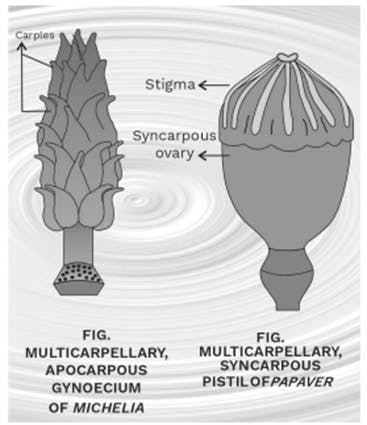
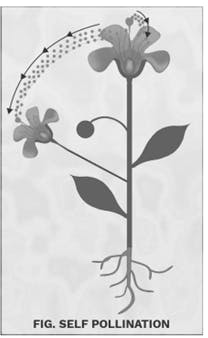


Agents of pollination
There are two main agents -
o Abiotic
o Biotic
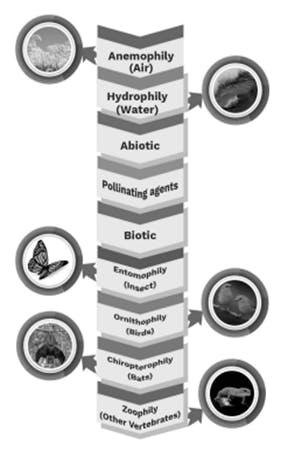
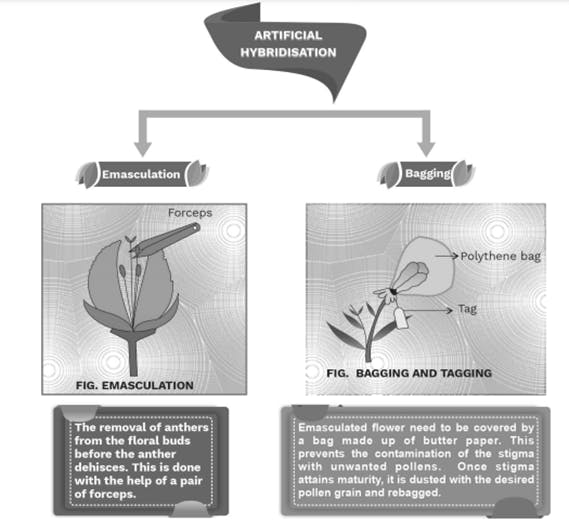
OUTBREEDING DEVICES : Certain devices in the plants ensure that self-pollination does not take place and cross-pollination occurs to ensure variations and better chances of survival in the changing environment.

SEXUAL INCOMPATIBILITY : The pollen grains do not germinate on the stigma of the same flower. Thus the male and female gametes of the same plants does not undergo fertilization.
Incompatibility involves the interactions of the pollen and the stigmatic tissue. It can be due to the genotype of the stigmatic tissue or the genotype of the pollen. y Self incompatibility is controlled by multiple alleles.

POLLEN-PISTIL INTERACTION : The pistil has the ability to recognise the pollen, whether it is compatible or incompatible. If it is compatible, the pistil accepts the pollen and promotes the formation of pollen tube for fertilization. y If the pollen is incompatible pollen germination does not take place on the stigma or the pollen tube does not grow through the style. y A chemical dialogue between the components of the pollen and the pistil results in the acceptance or rejection of the germination of the pollen tube















